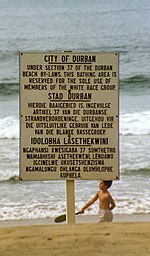| Part of the National Peace Accord | |
| Date | 24 October 1991 to 27 October 1994 |
|---|---|
| Duration | Three years, three days |
| Location | South Africa |
| Also known as | Goldstone Commission |
| Participants | Richard Goldstone (chair) Danie Rossouw Solly Sithole Lillian Baqwa Gert Steyn |
| Part of a series on |
| Apartheid |
|---|
 |
The Goldstone Commission, formally known as the Commission of Inquiry Regarding the Prevention of Public Violence and Intimidation, was appointed on 24 October 1991 to investigate political violence and intimidation in South Africa. Over its three-year lifespan, it investigated incidents occurring between July 1991 and April 1994, when democratic elections were held. The relevant incidents thus occurred during the negotiations to end apartheid.[1] The Commission's mandate was both to investigate the causes of the violence and to recommend measures to contain or prevent it.[2]
The Commission played a critical role in defusing the political violence that erupted when apartheid in South Africa began eroding in the late 1980s as the country moved toward its first democratic elections, and concluded that political violence was fuelled by a 'third force'.[citation needed]
The Commission was established in terms of the Prevention of Public Violence and Intimidation Act of 1991,[3] as a condition of the National Peace Accord of September 1991. President F. W. de Klerk appointed Justice Richard Goldstone to chair it. It operated from 24 October 1991 to 27 October 1994 and, over that period, submitted 47 reports to the President.[4] The Commission was fairly large: its investigation team, set up in 1992, comprised five units, staffed by 13 police officers, ten attorneys, and five international observers. It had offices in Johannesburg, Durban, Port Elizabeth, Cape Town, and East London.[5]
Some of the Commission's reports focused on broad thematic concerns, such as taxi violence (to which seven separate reports were dedicated) or the effects of political violence on children. Others investigated specific allegations or events, among them some of the most prominent incidents of political violence of the period, including the Boipatong massacre, the Bisho massacre, the storming of the Kempton Park World Trade Centre, and the Shell House massacre. Several reports investigated the role of the South African Police and South African Defence Force in political violence, and particular public attention was given to the May 1993 report on allegations of a third force, as well as to related reports such the report of the Malcolm Wallis-led subcommittee on the causes of the violence between the African National Congress and Inkatha.
- ^ Commission of Inquiry Regarding the Prevention of Public Violence and Intimidation (Goldstone Commission), Human Rights Institute of South Africa, archived from the original on 6 January 2010, retrieved 27 May 2010
- ^ Shaw, Mark (1993). "The Goldstone Commission". Indicator SA. 11 (1).
- ^ "Prevention of Public Violence and Intimidation Act 139 of 1991". South African Government. Retrieved 2021-11-29.
- ^ Project report relating to the Goldstone Commission (PDF). Human Rights Institute of South Africa.
- ^ Report on the Investigation Units of the Goldstone Commission: 1 October 1992–30 September 1993 (PDF). Braamfontein: Goldstone Commission. 1993.
© MMXXIII Rich X Search. We shall prevail. All rights reserved. Rich X Search
